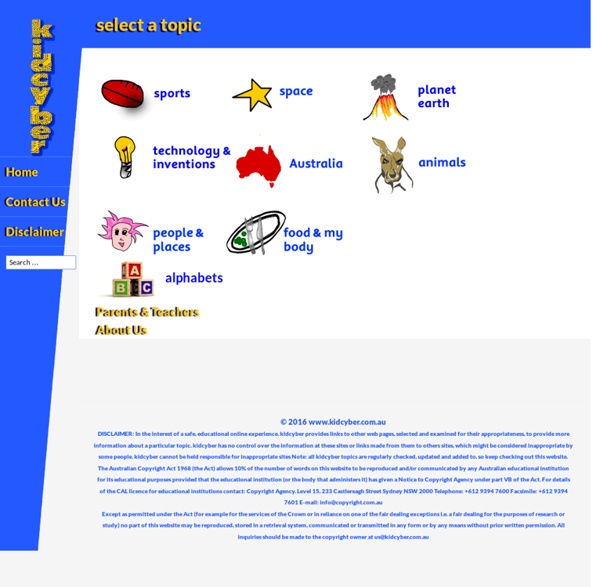



Boolify Mobile: Boolean Search Teaching Tool Word or phrase Exact word or phrase Not Or Site intitle inurl filetype Drag/Drop a green word or phrase above. SafeSearch results will appear below. Keyboard Shortcut: Boolify Video Tutorial About Boolify: Boolify is a great tool to teach children (and adults too!) While those with experience may find the boolean concept intuitive, it is often a challenge for people that are beginning to learn how to use a search engine. The fun part comes next - adding refinement blocks, like AND, OR, NOT to narrow things down. After each operator block is added or removed, the actual Google command line shortcut search is also shown right above the search results. Now go Boolify!
Tom Yum Soup - Tom Yum Soup Recipe Soup to boost your immune system? That's right! Tom Yum soup is currently under study for its ability to fight off cold and flu viruses, and perhaps even cancer (see link below for more information). So try my delicious version of Tom Yum Goong, which is basically Tom Yum soup but with a little coconut milk added ("Tom Khaa"). The coconut milk gives it a little more thickness and flavor while still keeping it healthy. It's an easy recipe, and quick to cook up, but tastes like Thai restaurant quality. Prep Time: 15 minutes Cook Time: 10 minutes Total Time: 25 minutes Yield: SERVES 2-3 Ingredients: Preparation: For a simple step-by-step version of this recipe, see: Easy Tom Yum Soup Recipe. About Tom Yum Soup and Coconut Milk: Depending on which Thai chef is cooking, evaporated milk may be added instead of coconut milk (this is often the case in Thailand). For more on the immune-boosting benefits of Tom Yum soup, see: Thai Soup Under Study.
Sweet Search Anna Gare : Celebrity Chef | LifeStyle FOOD When she was 12 and three quarters, desperately wanting to be 13, she formed an all girl band with her sister and two friends called the “Jam Tarts”. For ten years the Jam Tarts were a successful touring and recording band within Australia and acclaimed at international music festivals. While Anna was in the Jam Tarts, she supplemented her rock and roll lifestyle with cooking, where she honed her talents in various restaurants around Australia. After a decade of rock and roll, it was time for a change. Anna also began working in Television. Following her TV experience with Ian, Anna went on to presenting her own cooking segment on magazine chat show called Perth at Five. Last year Anna co-starred with chefs Ben O’Donoghue and Darren Simpson in The Best in Australia on The LifeStyle Channel.
instaGrok.com Science NetLinks: Crops 1: Where Does Food Come From? Purpose To help students understand that most of the food we eat comes from farms. Context This is the first lesson of a two-part series on where food comes from. In Crops 1: Where Does Food Come From? In Crops 2: What Plants Need to Grow, students focus on the second part of the central benchmark by learning how to grow plants and about the kinds of things that promote growth (warmth, sunlight, water, soil). While teaching, keep in mind that a lot of people never see food or fiber before those products get to retail stores and that primary-school children may have only vague ideas about where their foods and fabrics come from. Students will also benefit from knowing that many people are involved in the farming industry. The basic experiences of students at this early level include seeing plants grow from seeds they have planted, eating the edible portions of the mature plants, and noticing what plants and other things animals eat. Read More Planning Ahead Motivation Development Assessment
1,150 Free Movies Online: Great Classics, Indies, Noir, Westerns Watch 4,000+ movies free online. Includes classics, indies, film noir, documentaries and other films, created by some of our greatest actors, actresses and directors. The collection is divided into the following categories: Comedy & Drama; Film Noir, Horror & Hitchcock; Westerns (many with John Wayne); Martial Arts Movies; Silent Films; Documentaries, and Animation. Free Comedy & Dramas 125 Korean Feature Films — Free — The Korean Film Archive has put on YouTube over 100 Korean feature films, including Im Kwon-taek’s Sopyonje and Hong Sangsoo’s The Day the Pig Fell Into a Well. A bonanza for fans of Korean film.70 Movies in HD from Famed Russian Studio Mosfilm — Free — Includes films by Tarkovsky, Eisenstein and Kurosawa. Free Hitchcock, Noir, Horror & Thriller Films A Bucket of Blood - Free — Roger Corman’s classic comedy/horror film set in Bohemian San Francisco. Free Kung Fu & Martial Arts Films